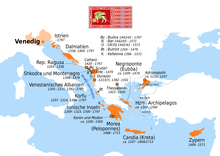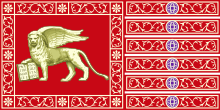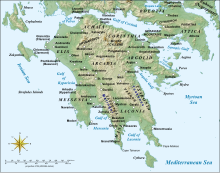Swiss troops in Venetian service
Twelve Swiss troops were in Venetian service from 1573 to 1719 . In the eastern Mediterranean, the military forces of the Republic of Venice , which consistently included Swiss troops from 1573 to 1719 , could not prevent the Ottomans from gradually snatching Cyprus, Crete and the Peloponnese from them.
Swiss troops in foreign service was the name of the paid service of commanded, whole troop bodies abroad,regulatedby the authorities of the Confederation byinternationaltreaties. These treaties contained a chapter that regulated military affairs: the so-called surrender or private surrender when one of the contracting parties was a private military contractor.
Overview of the Swiss troops in the Venetian service
|
in the war with the Ottomans for Cyprus and Crete 1571–1681 |
||
| # ven | designation | year |
| 83. Doge Gerolamo Priuli 1559-1567 | ||
| 1 | Lussy regiment | 1560-1573 |
| 92. Doge Giovanni Bembo 1615-1618 | ||
| 2 | Salis Regiment | 1616-1619 |
| 3 | Salis Company | 1617-1620 |
| 99. Doge Francesco Molin 1646-1655 | ||
| 4th | Werdmüller regiment | 1648-1651 |
| 5 | Escher Regiment | approx. 1650-1660 |
| 103. Doge Giovanni Pesaro 1658–1659 | ||
| 6th | Regiment of Weiss | 1658-1661 |
|
in the war with the Ottomans for the Peloponnese 1683-1719 |
||
| # ven | designation | year |
| 106. Doge Alvise Contarini 1676-1684 | ||
| 7th | Company of Augsburg | 1681 |
| 107. Doge Marcantonio Giustinian 1684-1688 | ||
| 8th | Von Roll Regiment | 1686 |
| 109. Doge Silvestro Valier 1694-1700 | ||
| 9 | Schmid regiment | 1696-1697 |
| 111. Doge Giovanni II. Cornaro 1709-1722 | ||
| 10 | Regiment Müller | 1716-1719 |
| 11 | Stockar Regiment | 1716-1719 |
| 12 | Salis Regiment | 1716-1719 |
Initial situation: the loss of Cyprus

When it first requested a Swiss force in 1573 , the Republic of Venice was already on the decline. Two generations earlier, the Portuguese Vasco da Gama had opened up the sea route to India. This was the beginning of the end for the economy of Venice, once the undisputed and prosperous hub of trade with the Orient via the Silk Road .
1571, in August, began the military decline of the Republic of Venice " Serenissima " (Italian: Serenissima Repubblica di San Marco , Most illustrious Republic of St. Mark). After a tough defensive battle for a year, the Republic of Venice lost the island of Cyprus to the Ottomans. Venice also clearly followed Pope Pius V's call to the Christian Mediterranean countries to oppose the Ottoman expansion in a Holy League , to which Spain under Philip II , the Maritime Republic of Genoa , all of the northern Italian duchies, the city republic of Lucca and the Knights of Malta belonged. The city's supreme warlord, Doge Alvise Mocenigo I, was even able to immediately provide 110 of the 211 ships from the arsenal to the Western fleet under the command of Don Juan de Austria , which were transferred to the Ottoman fleet at Lepanto in October 1571 met. But it would be the last time that the proud republic played a role in the concert of the mighty. In the sea battle, the Ottomans suffered a crushing defeat under their commander Kaptan-i Derya Ali Pasha , who was killed in the process. But its financially and militarily limited resources and the dwindling support from Philip II forced Venice in 1573 to finally cede Cyprus to the Ottomans in a separate peace.
After the battle of Lepanto in 1571
In 1573, following an earlier treaty of Nidwalden from 1560, the Catholic towns granted Venice the first permission for a troop from central Switzerland to move to Dalmatia.
| Name, duration of use |
(1 ven ) Lussy regiment 1560–1573 |
| Year, contractual partner |
1560, private capitulation of Landammann von Unterwalden and Colonel Melchior Lussi with Venice, approved by Unterwalden.
In peacetime, the Republic of Venice paid him 1,200 scudi a year for the maintenance of twelve captains, whom he had to take on oath and always keep available. In the event of war, he had to raise twelve companies of 300 men within one month of receiving the order, each of which was paid 1500 Scudi per month. 1,000 scudi were earmarked for the colonel and his staff. The contract was for four years (with a two-year extension option for Venice). After this period, Lussi had to request a renewal. While the treaty was running, Lussi and his captains were not allowed to serve other princes. They had to fight against everyone, except against the Pope and his church, and, if necessary, their own canton should take precedence over foreign services. 1573 Surrender between the Republic of Venice and the cantons of Uri, Schwyz, Unterwalden, Lucerne, Zug, Solothurn, Freiburg. |
| Stock, formation |
1 regiment with a target population of 3,000 men. |
| Owner, commander, namesake |
Recruited by Colonel Melchior Lussi from Unterwalden, from 1558 (until his death in 1606) provided with a Venetian pension. |
| Origin squad, troop |
Enlisted in the Catholic places.
In 1571 Lussi named the following captains: Hans Waser, son Melchior Lussi, brother Wolfgang Lussi, all three from Unterwalden; Caspar Abyberg, Hans Gasser, father-in-law Jost Aufder Maur, Balthasar Luchsinger, known as Mürdi, all four from Schwyz; the two brothers Johannes and Walter Zumbrunnen and Ambrosius Büntener, all three from Uri. |
| Use, events |
Requested by Venice for the first time in 1573, the service in the garrison Zara ( Zadar ) in Dalmatia was planned. When Lussi entered Venice with 1,600 men and 1,085 rowers, the separate peace with the Ottomans was already in place. He had to lead his regiment back to Switzerland without having achieved anything. |
Troubled by the growing influence of Habsburg in the Adriatic, the advance of the Ottomans in the eastern Mediterranean and the increasing tensions with the Pope , shortly after the turn of the century the Doge Leonardo Donà sought contact with the Confederates again through his negotiator Gregorio Barbarigo, this time with the neighboring three Bünden (today: Graubünden) and the two large Protestant towns of Bern and Zurich:
In 1606, the Three Leagues signed a formal offensive and defensive treaty with Venice that was valid for 100 years. In 1616 Bern and Zurich followed with their own alliance. It was ratified by the Venetian Grand Council the following year and solemnly invoked in Zurich in 1618.
| Name, duration of use |
(2 ven ) Regiment of Salis 1616–1619 | |
| Year, contractual partner |
1616, capitulation between the Republic of Venice and the Three Leagues. | |
| Stock, formation |
1 regiment of 3,000 men. | |
| Owner, commander, namesake |
Excavated by Colonel Hercules von Salis from Grüsch. | |
| Origin squad, troop |
Excavated in the three frets. | |
| Use, events |
Use against the Uskoks in Istria and 1618 in Venice in the uncovering of the Spanish conspiracy of (Manuel-) Pedro Girón de Velasco, Duke of Osuna and Viceroy of Naples, and Alfonso de la Cueva-Benavides y Mendoza-Carrillo, Marquis of Bedmar and Spanish ambassador in Venice, who had planned a coup d'état on the city by German mercenaries. |
| Name, duration of use |
(3 ven ) Company of Salis 1617–1620 | |
| Year, contractual partner |
1617, capitulation between the Republic of Venice and the Three Leagues. | |
| Stock, formation |
1 company of 300 men. | |
| Owner, commander, namesake |
Under Captain Ulysses von Salis von Marschlins, son of the aforementioned Hercules von Salis from Grüsch (Graubünden). | |
| Origin squad, troop |
Excavated in the three frets. | |
| Use, events |
Siege of Gradisca during the conflict with Austria . | |
The war with the Ottomans over Crete 1645–1669
In 1630, the plague broke out in the overcrowded city, killing a third of the residents and causing lasting damage to the Venetian economy. In addition, in 1645 a 24-year conflict began with the Ottomans in the Aegean and Greece, in which Crete and parts of the Peloponnese were finally lost to the Ottomans. In this context, too, Venice resorted to its federal allies.
| Name, duration of use |
(4 ven ) Werdmüller Regiment 1648–1651 | |
| Year, contractual partner |
1648, capitulation between the Republic of Venice and the cantons of Bern and Zurich. |

Johann Rudolf Werdmüller at 62 by Matthäus Merian
|
| Stock, formation |
1 regiment of 2,200 men in 2 battalions with 11 companies (6 from Zurich and 5 from Bern). | |
| Owner, commander, namesake |
Excavated by Colonel Johann Rudolf Werdmüller from Zurich. | |
| Origin squad, troop |
Partly forcibly recruited (unpopular people, delinquents, Anabaptists, etc.) in Bern and Zurich, which made the troops prone to desertion. | |
| Use, events |
deployed in the permanent positions in Dalmatia against the Ottomans, Werdmüller got into a dispute with the Venetian high command over compliance with the surrender rule with regard to detachments, with poor meals and non-payment as a result. There was no combat mission, but the unfavorable conditions, the unfamiliar climate and diseases caused the population to melt to around 800 men before the regiment returned to Venice in 1650 and was released the next year. Wegmüller had led his troop with a hard hand and had to justify himself to the Zurich council. The settlement of the outstanding pay claims took some time. | |
| Name, duration of use |
(5 ven ) Escher regiment approx. 1650–1660 | |
| Year, contractual partner |
k. A. |

Republic of Venice with Dalmatia
|
| Stock, formation |
1 regiment of 3,000 men. | |
| Owner, commander, namesake |
Excavated by Colonel Johann Peter Escher from Zurich, who had previously served under Gustav II Adolf in the Thirty Years' War . | |
| Origin squad, troop |
For the most part made up of German teams. | |
| Use, events |
Use in Dalmatia and Kandia (Crete). |
|
| Name, duration of use |
(6 ven ) Regiment von Weiss 1658–1661 | |
| Year, contractual partner |
1658, surrender between the Republic of Venice and the cantons of Bern and Zurich. | |
| Stock, formation |
1 regiment of 1,200 men in 2 battalions. | |
| Owner, commander, namesake |
Excavated by Colonel Gabriel von Weiss von Molens, Burger von Bern. Weiss had already been in Venetian service with the Werdmüller regiment from 1648–1651. | |
| Origin squad, troop |
k. A. | |
| Use, events |
Use in Corfu. | |
In 1665 Venice asked again in Zurich and Bern for a regiment of 2,000 men. Warned by the obviously bad experiences in the two previous excerpts by Escher and Weiss, the cantons tightened the requirements in the surrender significantly, which dragged out the negotiations with the Venetian resident in Zurich, Francesco Giavarino. With Georg Werdtmüller the regimental commander had already been determined when Venice finally decided not to advertise. In 1681 Venice even considered the danger of an enemy attack to be non-existent and the 8,000 ducat annual commission to the two cities as too high and canceled the contract. The alliance with the Catholic cantons continued, however.
The wars with the Ottomans for the Peloponnese 1683–1699 and 1714–1718
In 1683 the Ottoman siege army was forced to withdraw from Vienna on the Kahlenberg . This fortunate and fateful victory had also given rise to new courage in Venice. 1683–1687 managed the capable condottiere and later doge Francesco Morosini , also with the deployment of Swiss troops, to temporarily bring the whole Peloponnese under control again. But in 1718, in the Peace of Passarowitz, the Peloponnese was finally lost to the Ottomans. The resistance of the Greek population against the Venetians was, after centuries of arbitrariness, greater than their fear of the Ottomans. After all, Venice was able to gain land in Dalmatia.
| Name, duration of use |
(7 ven ) company from Augsburg 1681 | |
| Year, contractual partner |
No official surrender (private surrender?). | |
| Stock, formation |
1 free company of 400 men. | |
| Owner, commander, namesake |
Excavated by Captain David Augsburger von Bern. | |
| Origin squad, troop |
k. A. | |
| Use, events |
The company was almost completely destroyed in battles against the Ottomans in the Peloponnese. Only a few escaped the fighting, atrocities of war and epidemic diseases. | |
| Name, duration of use |
(8th ven ) Regiment von Roll 1686 |
| Year, contractual partner |
1686, capitulation between the Republic of Venice and the cantons of Uri, Schwyz, Unterwalden, Lucerne, Zug, Solothurn, Freiburg. |
| Stock, formation |
1 regiment of 2,400 men in 3 battalions. |
| Owner, commander, namesake |
Excavated by Colonel Johann Ludwig von Roll von Emmenholz from Solothurn. |
| Origin squad, troop |
k. A. |
| Use, events |
The regiment was almost completely destroyed in fighting in the Peloponnese against the Ottomans. Only about the tenth part escaped the fighting, atrocities of war and epidemic diseases. |
| Name, duration of use |
(9 ven ) Schmid Regiment 1688-1691 | |
| Year, contractual partner |
1688, surrender between the Republic of Venice and the cantons of Uri, Schwyz, Unterwalden, Lucerne, Zug, Solothurn, Freiburg.
Article 1 read:
The period of service was agreed to be 3 years. |
|
| Stock, formation |
1 regiment of 2,500 men. |

Musketeer with forked musket, sword and bandolier with powder horn, the burning fuse in his left hand,
17th century |
| Owner, commander, namesake |
Under Colonel Sebastian Peregrin Schmid from Altdorf. | |
| Origin squad, troop |
The officers known are: Oberwachtmeister Johann Franz Zurlauben, Captain Josef Anton Bessler, Captain Johann Peter Püntener, Captain Johann Franz Brücker, Captain Johann Franz Scolar, Captain Johann Sebastian Reding, Ensign Florian Schmid, Ensign Johann Josef Stricker, Ensign Capellet, Ensign Crivelli (all from Uri), Colonel Joseph Heller, Captain Johann Rochus Abyberg (both from Schwyz), Lieutenant Colonel Achermann from Obwalden, Colonel Urs Joseph Byss from Solothurn. The military chaplains were the Capuchin Fathers Leo Jütz from Schwyz and Dionys Hochstrasser from Stans and the Benedictine Dr. theol. Paul François from Einsiedeln divided. After Freiburg and Lucerne withdrew from advertising, the team was lifted in the other Catholic cantons. While Obwalden expressed difficulties with this, the will in Uri to go to war against the "Turks who threaten Christianity" was more effective. | |
| Use, events |
After the regiment had gathered in Altdorf and the Gotthard Pass had been crossed in winter with the first loss of crew, the entry inspection took place in Bergamo. A second followed in Venice on the Lido by French officers. They judged with the intention of hindering this advertising, which is not acceptable to France, as much as possible, sometimes in a harassing manner. General Mocenigo , the commander, finally moved his combat group consisting of Swiss, Venetians, German mercenaries and 1,000 men and 120 horsemen of the Maltese knights by ship to the ready room in the port of the island of Poros . The basic position to attack the city of Chalkis, later on the island of Evia , soon turned into a sick bed. In a short time, large parts of the crew, including regimental commander Schmid and his deputy Zurlauben, were killed by an epidemic epidemic (flu?). They had designated Captain Abyberg as their successor. But the seedy Colonel Joseph Heller invoked his senior position and usurped the command. Apparently he also took possession of the personal equipment of his predecessors. During the assaults on the fortified city with the battle cry "Giesu con noi!", Which, however, did not get beyond the outer works, he is said to have "reported sick" and hid behind bulwarks. He only escaped the court martial because the honor of the brave regiment did not deserve this shame. Illness and the great losses in the numerous assault attacks had meanwhile reduced the regiment to company strength, so that the commandant Mocenigo III., Whose remaining troops had almost disbanded through desertion, broke off the siege and transferred the meager remainder of the Swiss troops back to Patras. From there, Colonel Heller simply left for his home country without completing his mandate to get the regiment to return home early in Venice. Despite two requests for help from the Schwyz authorities to the Pope, his troops were retained as a protective force in Nafpaktos beyond the contractual period of service before they were released under Colonel Joseph Byss, who was appointed by the Venetian High Command, and transported back to Venice. In 1691 a group of barely 200 men came back over the Gotthard with Lieutenant Colonel Achermann and the desperation in central Switzerland over the enormous losses was great. The only company of the Prince-Bishop of St. Gallen in the regiment brought home less than a dozen of the originally over 200 men. As one contemporary historian put it:
The machinations and thefts of Colonel Heller then led to political upset among the Swiss cantons. In any case, Heller himself had to hide in the Seedorf Monastery for three years in order not to be lynched by the relatives of the fallen. The collection of the arrears in Venice is said to have taken even longer. |
|
As early as 1701, after the Catholic regiments of Roll and Schmid had suffered terrible losses and miserable treatment from Venice, Bern and Zurich were attacked again, now by the resident Vendramino Bianchi, for 2 regiments of 1,000 men. Fought by the Swiss officers in the French and Dutch services as well as the foreign ambassadors who feared for their own recruitment, the negotiations lasted even longer this time. In 1705, however, they ended in a proposal for a surrender of 28 strictly worded articles. The respected Colonel Gabriel von Weiss, with his obviously bitter experiences, criticized this emphatically, point by point. He recommended either tightening it up or even rejecting the whole application because
“ Then it is unbelievable what is done to an honest man there [in Venice] in front of prescribed rascal pieces ... [] ... and [one should] consider that one has dealt with Italians ... [] ... the experience that the former, so concluded in 1658 by the resident Sarotti, and promised in the least not been kept . "
But regardless of his warnings, the treaty was passed by the Diet and solemnly sworn in 1706 in the Grossmünster and City Hall of Zurich with a great ceremony. The Venetian representative gave the guilds a silver cup, all members of the small and large council a medal specially embossed for the celebration and each of the four members of the Bern and Zurich delegates a gold chain. Former mayor Johann Rudolf Sinner of Bern was even knighted by San Marco in the end. The 100 men of the city watch, responsible for the security of the event, got nothing. But the venerable, strict, honorable and highly praiseworthy dignitaries were touched by the importance of the moment and themselves. The payments made by Venice to the troops in action, however, should still be slow or even not at all!
| Name, duration of use |
(10 ven ) Müller regiment 1716–1719 | |
| Year, contractual partner |
1716, capitulation between the Republic of Venice and the cantons of Berne, Zurich, Uri, Schwyz, Unterwalden, Lucerne, Zug, Solothurn, Freiburg and the 3 leagues. | |
| Stock, formation |
1 regiment of 1,800 men in 3 battalions (1 from Zurich and Bern, 2 from the Catholic cantons) with 4 companies. | |
| Owner, commander, namesake |
Under Colonel Johann Georg Müller from Glarus. | |
| Origin squad, troop |
Excavated in Bern, Zurich, Uri, Schwyz, Unterwalden, Lucerne, Zug, Solothurn and Freiburg. | |
| Use, events |
Use in Dalmatia and on the Peloponnese against the Ottomans. After the peace treaty in 1718 in a garrison on Corfu. Dismissed at the end of the capitulation in 1719 and returned to Switzerland. | |
| Name, duration of use |
(11 ven ) Regiment of Stockar 1716–1719 | |
| Year, contractual partner |
1716, capitulation between the Republic of Venice and the cantons of Berne, Zurich, Uri, Schwyz, Unterwalden, Lucerne, Zug, Solothurn, Freiburg and the 3 leagues. | |
| Stock, formation |
1 regiment of 1,800 men in 3 battalions with 4 companies. | |
| Owner, commander, namesake |
Under Colonel Stockar from Neunforn Schaffhausen. | |
| Origin squad, troop |
Excavated in Zurich and Schaffhausen. | |
| Use, events |
Use in Dalmatia and on the Peloponnese against the Ottomans. After the peace treaty in 1718 in a garrison on Corfu. Dismissed at the end of the capitulation in 1719 and returned to Switzerland. | |
| Name, duration of use |
(12 ven ) Regiment of Salis 1716–1719 |
| Year, contractual partner |
1716, capitulation between the Republic of Venice and the cantons of Berne, Zurich, Uri, Schwyz, Unterwalden, Lucerne, Zug, Solothurn, Freiburg and the 3 leagues. |
| Stock, formation |
1 regiment of 1,800 men in 3 battalions with 4 companies. |
| Owner, commander, namesake |
Under Colonel Andreas von Salis. |
| Origin squad, troop |
Excavated in the three frets. |
| Use, events |
Use in Dalmatia and on the Peloponnese against the Ottomans. After the peace treaty in 1718 in a garrison on Corfu. Dismissed at the end of the capitulation in 1719 and returned to Switzerland. |
In 1719 these were the last three Swiss troops in the Venetian service. They then moved to Spain.
Decline and end
The sea route to India had increasingly displaced the very large trade flows from the Adriatic. This led to the final demise of the once proud Republic of Venice. When the Napoleonic troops broke the flare-up resistance on the "Terra Ferma" (mainland part of Venice) in 1797, the Venetian Grand Council dissolved the republic and the last doge, Ludovico Manin , surrendered the city without a fight. The millennial history of the "Serenissima" was finally over. In 1866 Venice was finally annexed to the unified state of Italy that was created in 1861 .
See also
- Swiss troops in foreign service
- List of Venetian regiments of the early modern period
- Republic of Venice
- Turkish siege of Crete 1648–1669
- Venetian-Austrian Turkish War 1714–1718
literature
- Beat Emmanuel May (by Romainmotier): Histoire Militaire de la Suisse et celle des Suisses dans les differents services de l'Europe , Tome VII, JP Heubach et Comp., Lausanne 1788, OCLC 832583553 .
- Karl Müller von Friedberg : Chronological representation of the federal surrender of troops to foreign powers. Huber and Compagnie, St. Gallen 1793, OCLC 716940663 .
- Moritz von Wattenwil: The Swiss in foreign military service. Separately printed from the Berner Tagblatt , Bern 1930, OCLC 72379925 .
- Paul de Vallière, Henry Guisan , Ulrich Wille : Loyalty and honor, history of the Swiss in foreign service (translated by Walter Sandoz). Les editions d'art ancien, Lausanne 1940, OCLC 610616869 .
- Viktor Ruckstuhl: Departure against the Turks: an unusual pay service at the end of the 17th century with special consideration of Obwalden and the company Schönenbüel , Chronos, Zurich 1991, ISBN 3-905278-89-8 (dissertation University of Zurich 1991, 291 pages), OCLC 30583675 .
credentials
- ↑ a b c d e f g h i j k Moritz von Wattenwil: The Swiss in foreign military service . Separate print from the Berner Tagblatt , Bern 1930
- ↑ Franz Auf der Maur, Marriages and Friendships: Nidwalden and Schwyz , communications of the historical association of the Canton of Schwyz, Volume 83, 1991
- ↑ Fabian Hodel: Lussi, Melchior. In: Historical Lexicon of Switzerland .
- ↑ a b c d e f g h i j Heinrich Türler, Viktor Attinger, Marcel Godet, Historisch-Biographisches Lexikon der Schweiz , fourth volume, Neuchâtel, 1927
- ^ Silvio Färber: Salis, Hector. In: Historical Lexicon of Switzerland .
- ^ Rainer Henrich: Werdmüller, Johann Rudolf. In: Historical Lexicon of Switzerland .
- ↑ Braun Hans: Weiss, Gabriel. In: Historical Lexicon of Switzerland .
- ↑ Karl Müller von Friedberg, Chronological representation of the federal surrender of troops to foreign powers , Huber und Compagnie, St. Gallen, 1793
- ↑ Erich Meyer: Roll, Johann Ludwig. In: Historical Lexicon of Switzerland .
- ↑ a b c Franz Christen, Morea 1688: the Urner in "Aufbruch gegen die Türken" , Historisches Neujahrsblatt / Historischer Verein Uri, Volume 87–88, 1996–1997
- ↑ Urs Kälin: Schmid, Sebastian Peregrin. In: Historical Lexicon of Switzerland .
- ^ Protocol Kanzley Bern, Loosening of the Alliance, dissolution and renewal of the same 1661-1706 , Archives of the Historical Association of the Canton of Bern, Volume 15, Issue 1, Pages 104–129, 1897–1899
- ↑ Marti-Weissenbach, Karin: May, Beat Emmanuel (from Romainmotier). In: Historical Lexicon of Switzerland .
- ^ Meuwly, Olivier: Valliere, Paul de. In: Historical Lexicon of Switzerland .

















